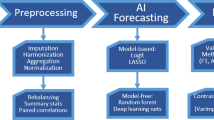Abstract
Patient follow-up appointments are an imperative part of the healthcare model to ensure safe patient recovery and proper course of treatment. The use of mobile devices can help patient monitoring and predictive approaches can provide computational support to identify deteriorating cases. Aiming to aggregate the data produced by those devices with the power of predictive approaches, this paper proposes the eWound-PRIOR framework to provide a remote assessment of postoperative orthopedic wounds. Our approach uses Artificial Intelligence (AI) techniques to process patients’ data related to postoperative wound healing and makes predictions as to whether the patient requires an in-person assessment or not. The experiment results showed that the predictions are promising and adherent to the application context, even if the on-line questionnaire had impaired the training model and the performance.
Access this chapter
Tax calculation will be finalised at checkout
Purchases are for personal use only
Similar content being viewed by others
References
Marsh, J., Hoch, J.S., Bryant, D., MacDonald, S.J., Naudie, D., McCalden, R., Howard, J., Bourne, R., McAuley, J.: Economic evaluation of web-based compared with in-person follow-up after total joint arthroplasty. JBJS 96(22), 1910–1916 (2014)
Salvati, E., Robinson, R., Zeno, S., Koslin, B., Brause, B., Wilson, J.P.: Infection rates after 3175 total hip and total knee replacements performed with and without a horizontal unidirectional filtered air-flow system. J. Bone Joint Surg. Am. 64(4), 525–535 (1982)
Wildner, M., Peters, A., Hellich, J., Reichelt, A.: Complications of high tibial osteotomy and internal fixation with staples. Arch. Orthop. Trauma Surg. 111(4), 210–212 (1992)
Jeffery, W.G.: e-visits for early post-operative visits following orthopaedic surgery can they add efficiency without sacrificing effectiveness. Electronic Thesis and Dissertation Repository, vol. 5053 (2017). https://ir.lib.uwo.ca/etd/5053
Ali, F., Islam, S.R., Kwak, D., Khan, P., Ullah, N., Yoo, S.J., Kwak, K.: Type-2 fuzzy ontology–aided recommendation systems for IoT–based healthcare. Comput. Commun. 119, 138–155 (2018)
Mustaqeem, A., Anwar, S.M., Khan, A.R., Majid, M.: A statistical analysis based recommender model for heart disease patients. Int. J. Med. Inf. 108, 134–145 (2017)
Dreiseitl, S., Ohno-Machado, L.: Logistic regression and artificial neural network classification models: a methodology review. J. Biomed. Inform. 35(5–6), 352–359 (2002)
Araya, D.B., Grolinger, K., ElYamany, H.F., Capretz, M.A., Bitsuamlak, G.: An ensemble learning framework for anomaly detection in building energy consumption. Energy Build. 144, 191–206 (2017)
Zhou, Z.H.: Ensemble Learning, pp. 411–416. Boston. Springer, Heidelberg (2015)
Opitz, D., Maclin, R.: Popular ensemble methods: an empirical study. J. Artif. Intell. Res. 11, 169–198 (1999)
Rallapalli, S., Gondkar, R.: Big data ensemble clinical prediction for healthcare data by using deep learning model. Int. J. Big Data Intell. 5(4), 258–269 (2018)
Kurian, R.A., Lakshmi, K.: An ensemble classifier for the prediction of heart disease. Int. J. Sci. Res. Comput. Sci. 3(6), 25–31 (2018)
Tuli, S., Basumatary, N., Gill, S.S., Kahani, M., Arya, R.C., Wander, G.S., Buyya, R.: “Healthfog: An ensemble deep learning based smart healthcare system for automatic diagnosis of heart diseases in integrated IoT and fog computing environments. Fut. Gener. Comput. Syst. 104, 187–200 (2020)
Zhang, K., Liu, X., Jiang, J., Li, W., Wang, S., Liu, L., Zhou, X., Wang, L.: Prediction of postoperative complications of pediatric cataract patients using data mining. J. Transl. Med. 17(1), 2 (2019)
Rumelhart, D.E., Hinton, G.E., Williams, R.J.: Learning internal representations by error propagation. California Univ San Diego La Jolla Inst for Cognitive Science, Technical Report (1985)
Han, J., Pei, J., Kamber, M.: Data Mining: Concepts and Techniques. Elsevier, Amsterdam (2011)
Breiman, L.: Random forests. Mach. Learn. 45(1), 5–32 (2001)
McClelland, J.L., Rumelhart, D.E., Group, P.R., et al.: Parallel Distributed Processing, vol. 2. MIT press, Cambridge (1987)
Polikar, R.: Ensemble Learning, pp. 1–34. Springer, Heidelberg (2012)
Tan, C.C., Eswaran, C.: Using autoencoders for mammogram compression. J. Med. Syst. 35(1), 49–58 (2011)
Pedregosa, F., Varoquaux, G., Gramfort, A., Michel, V., Thirion, B., Grisel, O., Blondel, M., Prettenhofer, P., Weiss, R., Dubourg, V., et al.: Scikit-learn: machine learning in python. J. Mach. Learn. Res. 12(Oct), 2825–2830 (2011)
Braz, F., Campos, F., Stroele, V., Dantas, M.: An early warning model for school dropout: a case study in e-learning class. In: Brazilian Symposium on Computers in Education (Simpósio Brasileiro de Informática na Educação-SBIE), vol. 30, no. 1, p. 1441 (2019)
Lalkhen, A.G., McCluskey, A.: Clinical tests: sensitivity and specificity. Contin. Educ. Anaesth. Crit. Care Pain 8(6), 221–223 (2008). https://doi.org/10.1093/bjaceaccp/mkn041
Acknowledgments
ELAP from University of Western Ontario, Canada, Federal University of Juiz de Fora (UFJF), CAPES, CNPq and FAPEMIG.
Author information
Authors and Affiliations
Corresponding author
Editor information
Editors and Affiliations
Rights and permissions
Copyright information
© 2021 The Editor(s) (if applicable) and The Author(s), under exclusive license to Springer Nature Switzerland AG
About this paper
Cite this paper
Neves, F., Jennings, M., Capretz, M., Bryant, D., Campos, F., Ströele, V. (2021). eWound-PRIOR: An Ensemble Framework for Cases Prioritization After Orthopedic Surgeries. In: Barolli, L., Takizawa, M., Yoshihisa, T., Amato, F., Ikeda, M. (eds) Advances on P2P, Parallel, Grid, Cloud and Internet Computing. 3PGCIC 2020. Lecture Notes in Networks and Systems, vol 158. Springer, Cham. https://doi.org/10.1007/978-3-030-61105-7_12
Download citation
DOI: https://doi.org/10.1007/978-3-030-61105-7_12
Published:
Publisher Name: Springer, Cham
Print ISBN: 978-3-030-61104-0
Online ISBN: 978-3-030-61105-7
eBook Packages: EngineeringEngineering (R0)




